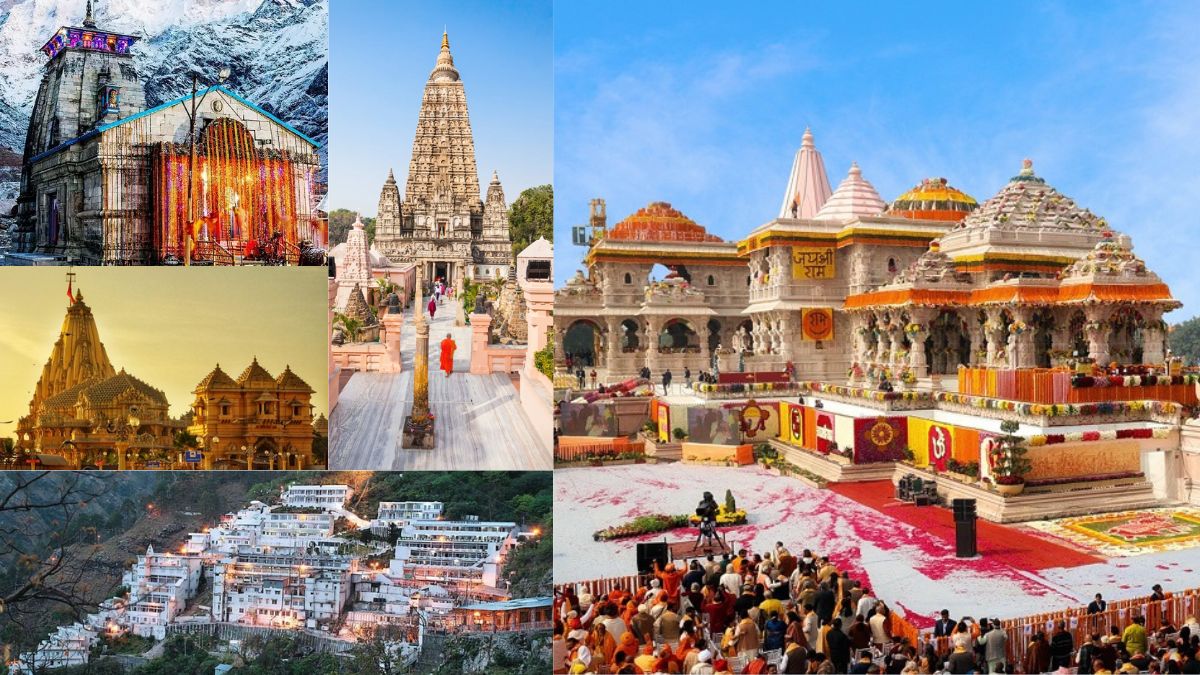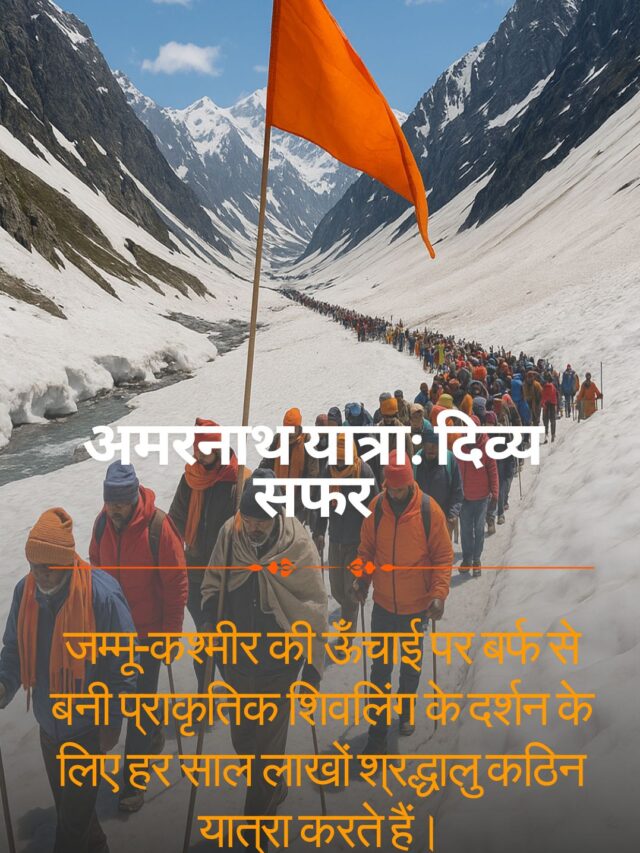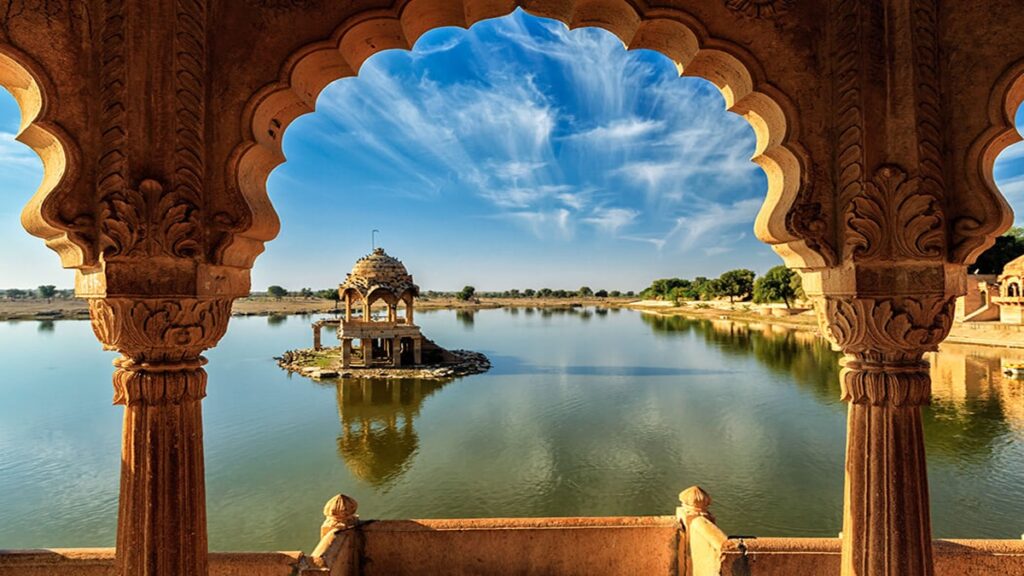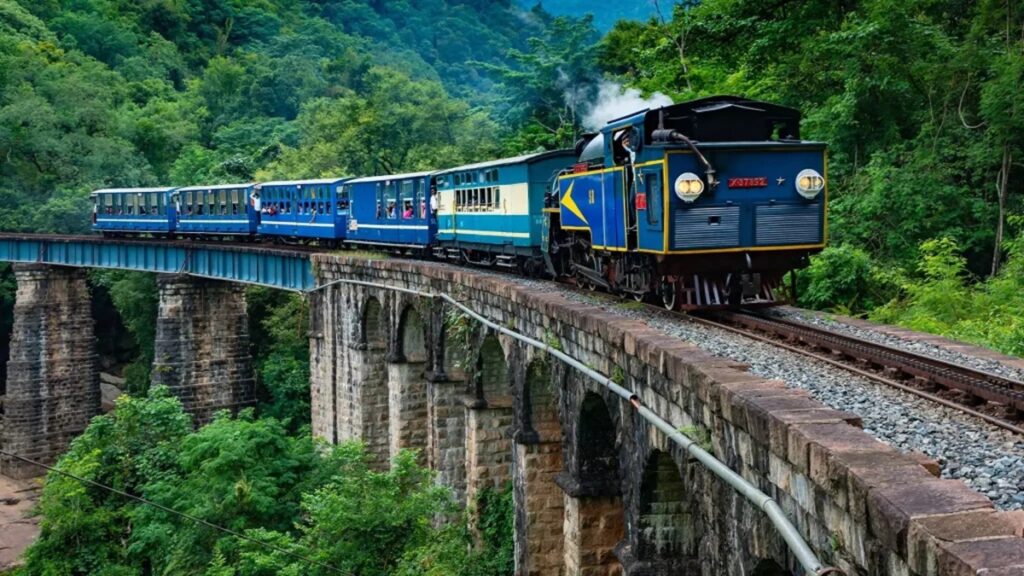Table of Content
Contents
India’s timeless allure lies in its wealth of sacred places to visit in India, making it a hub for spiritual tourism in India. From snow-clad Himalayan shrines to ancient South Indian temples, seven major pilgrimage circuits in India invite seekers to explore spiritual places in India steeped in mythology and devotion. Whether you follow the roaring chants at the Char Dham Yatra, trace the luminous Jyotirlinga temples, or find serenity on the Buddhist circuit in India, each route promises a journey of inner transformation. Join us as we traverse the Char Dham, the Jyotirlinga Circuit, the Buddhist Circuit, the Shakti Peethas, the Pancha Bhuta Sthalam, the Sikh pilgrimage circuit, and the Ramayana circuit—seven pillars of religious tourism India.
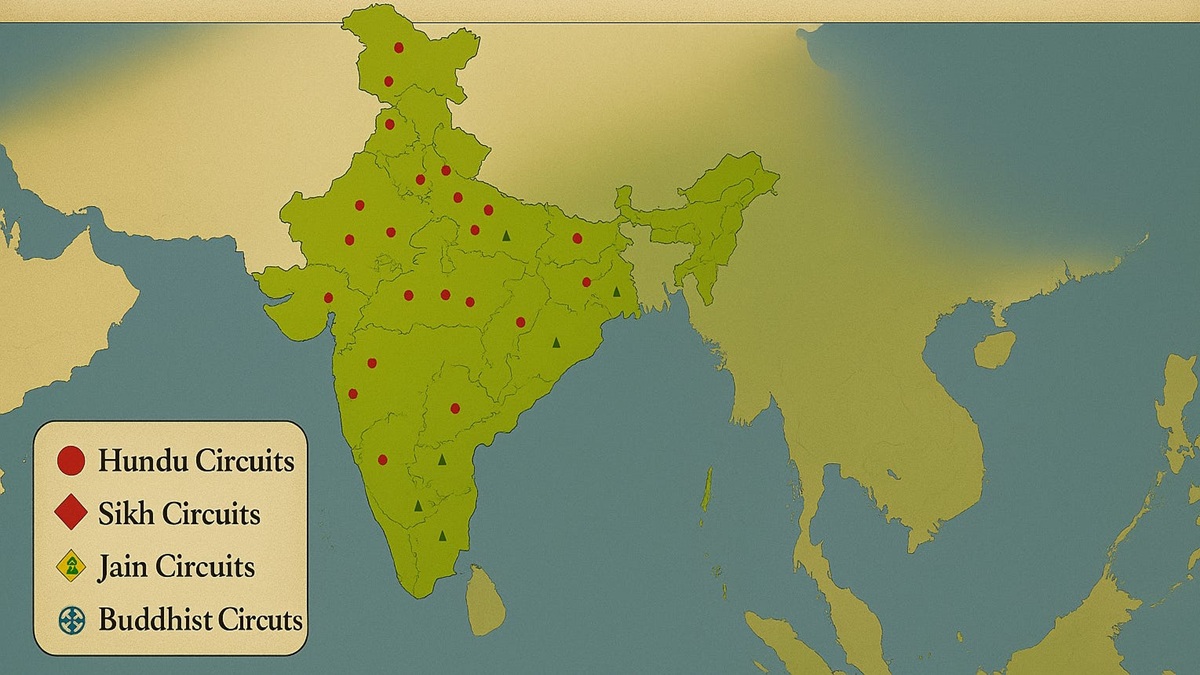
1. Char Dham Yatra—The Sacred Himalayan Circuit
The Char Dham Yatra is made up of the pilgrimages to Yamunotri, Gangotri, Kedarnath, and Badrinath; Adi Shankaracharya initiated this pilgrimage circuit in the 8th century to help devotees to find moksha. The Char Dham Yatra pilgrimages constitute an 825 km route across the Himalayas of Uttarakhand, and it is one of the most sacred Hindu pilgrimage sites. Pilgrim travel occurs most frequently from May to October, when the high-altitude passes are open.
- Yamunotri: A Vishnu shrine set at 3,300 m on the Alaknanda River, it forms the final leg of the Yatra.
- Gangotri: Origin of the Ganges, home to the 18th‑century temple of Goddess Ganga.
- Kedarnath: One of the twelve Jyotirlinga temples, dedicated to Lord Shiva, accessible by a 16 km uphill journey from Gaurikund.
- Badrinath: A Vishnu shrine located at 3,300 m on the Alaknanda River, it forms the final leg of the Yatra.
Beyond its rugged vistas, the Char Dham Yatra offers a blend of devotion, trekking, and Himalayan culture—cornerstones of spiritual places in India.
2. Jyotirlinga Circuit – The Path of Shiva Devotees
The Jyotirlinga Circuit commemorates the twelve avatars of Shiva’s limitless light. The Jyotirlinga temples are scattered from Somnath in Gujarat to Rameswaram in Tamil Nadu across over 6,500 km.
- Somnath (Gujarat):
Believed to be the first and most revered of the twelve Jyotirlingas, the Somnath Temple has been destroyed and re-established many times, a symbol of strength and devotion. Located along the west coast, it provides a scenic view of the Arabian Sea. - Mallikarjuna (Andhra Pradesh) and Mahakaleshwar (Madhya Pradesh):
Mallikarjuna, located in Srisailam, is surrounded by dense forests and is held sacred for its connection to both Shiva and Parvati. Mahakaleshwar, located in Ujjain, is the only Jyotirlinga that is oriented south and is of great importance in tantric worship and the Kumbh Mela festival.
- Omkareshwar (Madhya Pradesh):
Located on the holy island of Mandhata in the Narmada River, Omkareshwar is formed in the shape of the Hindu symbol ‘Om’ and is a prominent pilgrimage site. The temple is surrounded by scenic ghats and attracts pilgrims throughout the year for its spiritual atmosphere. - Rameswaram (Tamil Nadu):
Connected to the Ramayana circuit, Rameswaram is where Lord Rama is said to have prayed to Shiva before he sailed to Lanka. The temple has imposing gopurams and India’s longest corridor of stone pillars, making it an architectural and religious marvel by the sea.
Pilgrims normally spend two or three weeks to see all twelve, though geographical clusters—like the five Jyotirlingas of Maharashtra—can be seen in less than a fortnight. The circuit weaves together religious tourism in India and authentic regional cuisine, local festivals, and thousands of years of temple design.
3. Buddhist Circuit – Tracing the Path of the Buddha
The Buddhist circuit India links the life events of Siddhartha Gautama across India and neighboring Nepal .
- Lumbini (Nepal): Birthplace of Buddha.
- Bodh Gaya (Bihar): Site of enlightenment, with the UNESCO‑listed Mahabodhi Temple and sacred Bodhi Tree.
- Sarnath (Uttar Pradesh): Where Buddha gave his first sermon.
- Kushinagar (Uttar Pradesh): Place of Buddha’s parinirvana.
Modern pilgrimages take 7–10 days, departing from Delhi or Varanasi, with excursion options to Rajgir and historic Nalanda University in order to enhance the pilgrimage. Overseas travelers come in droves to attend guided meditation retreats, dharma talks, and experience the dynamic interplay of Indian and Southeast Asian Buddhist art—making it among the most popular spiritual tourism experiences in India.
4. Shakti Peethas – Power Centers of the Divine Feminine
The Shakti Peethas are 51 sacred places where fragments of the body of Goddess Sati fell, forming powerful centers of worship of Shakti. Eighteen Astadasha Maha Shakti Peethas are of supreme importance:
- Kamakhya (Assam): Renowned for the Ambubachi Mela, this influential Shakti Peetha worships the goddess’s fertility and is visited by thousands of tantric devotees every year.
- Vaishno Devi (Jammu & Kashmir): A sacred cave shrine within Trikuta Hills, accessed through a 12 km trek, visited by millions of devotees throughout the year.
- Kalighat (Kolkata) and Dakshineswar (West Bengal): Kalighat, an important Shakti Peetha, and Dakshineswar, which is connected with Ramakrishna, are the focus of Bengal’s deep-rooted goddess worship traditions.
Pilgrims take inter‑state pilgrimages—combining road journeys across Assam, West Bengal, and northern India—to witness tantric ceremonies, folk fairs, and devotional songs. This pilgrimage symbolizes religious tourism India with female divinity and tantric legacy.
5. Pancha Bhuta Sthalam – Temples Representing the Five Elements
In Tamil Nadu and Andhra Pradesh, the Pancha Bhuta Sthalam consists of five Hindu pilgrimage sites, each dedicating one of the five elements to Shiva’s avatar:
- Earth (Prithvi): Ekambareswarar Temple, Kanchipuram.
- Water (Appu): Jambukeswarar Temple, Thiruvanaikaval.
- Fire (Agni): Arunachaleswarar Temple, Tiruvannamalai.
- Air (Vayu): Sri Kalahasti Temple, Andhra Pradesh.
- Space (Akasha): Chidambaram Nataraja Temple, Tamil Nadu.
Dating back to between the 7th and 12th centuries, temples here feature Dravidian architecture at its best. A ten‑day trip during Maha Shivaratri connects them, presenting pilgrims with a unique journey of the elements and deep insights into South Indian arts of temples—pillars of holy sites in India.
6. Sikh Pilgrimage Circuit – A Journey of Service and Spirituality
The Sikh pilgrimage circuit revolves around the Golden Temple (Harmandir Sahib) in Amritsar, the spiritual heart of Sikhism and the most famous holy destination to travel to in India for Sikhism. Its perpetual running langar (community kitchen) feeds thousands a day, illustrating seva (selfless service).
Other key stops include:
- Anandpur Sahib (birthplace of the Khalsa).
- Hemkund Sahib (5,183 m in the Garhwal Himalayas).
- The five Takhts, including Patna Sahib and Hazur Sahib, which are temporal seats of authority.
The majority of pilgrims prefer a 7–10-day tour by bus or train, combining Amritsar with Chandigarh, Nanded, and Fatehgarh Sahib. The focus on simran (meditation), langar halls, and community kitchens highlights the Sikh principles of service and equality and makes it the highlight chapter of religious tourism India.
7. Ramayana Circuit – Retracing Lord Rama’s Exile
The Ramayana circuit follows Lord Rama’s 14‑year exile from Ayodhya to Rameswaram, weaving through Uttar Pradesh, Madhya Pradesh, Maharashtra, and Tamil Nadu :
- Ayodhya (Uttar Pradesh): Birthplace of Rama, now abodes the great Ram Janmabhoomi Temple, attracting devotees and symbolizing the revival of Hindu cultural heritage.
- Chitrakoot (Uttar Pradesh/Madhya Pradesh): Holy forest town where Rama, Sita, and Lakshmana lived through a portion of their exile; renowned for peaceful ghats and spiritual ashrams.
- Nashik (Panchavati): Connected with the abduction of Sita, Nashik has the holy Kalaram Temple and Panchavati district, abounding with Ramayana-period mythology and pilgrimage significance.
- Rameswaram (Tamil Nadu): Ramanathaswamy Temple contains an enormous 1,200-pillared corridor and lies close to mythological Ram Setu, linking it with Lanka’s epic tale.
Tour packages (10–14 days) combine heritage stays, river cruises, and enactments of the Ramlila. This circuit has experienced renewed interest under India’s “Incredible India” campaign, combining epic storytelling with contemporary hospitality for a memorable spiritual tourism in India experience.
Seven iconic pilgrimage circuits in India—from the lofty peaks of the Char Dham Yatra to the elemental temples of Pancha Bhuta Sthalam—map a route through India’s spiritual heart. Each trail, be it the light of the Jyotirlinga temples, the serene sites of the Buddhist circuit India, or the feminine power of the Shakti Peethas, embodies centuries of devotion, art, and ritual. For modern travelers seeking spiritual places in India and religious tourism India, these circuits offer both introspection and cultural immersion. Pack your satchel, ready your mantra, and prepare to explore the sacred places to visit in India that have guided pilgrims for millennia.
Subscribe Our Youtube Channel: https://www.youtube.com/@BhartiSanskriti-BS

